|
FAQs about Bivalve Mollusk Identification
3
Related Articles: Tridacnids, Bivalves, Mollusks,
Related FAQs: Bivalve
ID 1, Bivalve ID 2, Bivalve ID 4, & Bivalves 1, Bivalves 2, Bivalve
Behavior, Bivalve
Compatibility, Bivalve
Selection, Bivalve Systems,
Bivalve Feeding, Bivalve Disease, Bivalve Reproduction, Tridacnids, Tridacnid Clam Business, Tridacnid Identification, Tridacnid Selection, Tridacnid Compatibility, Tridacnid Systems, Tridacnid Lighting, Tridacnid Placement, Tridacnid Feeding, Tridacnid Disease, Tridacnid Reproduction, Flame Scallops,
|
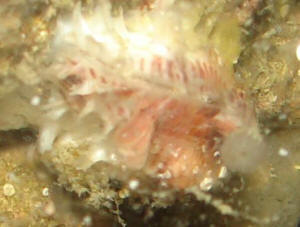
|
|
Carib critter IDs, if you would please
07/16/09
Howdy Crew,
There are some critters I cannot identify in my 150 gal Caribbean
biotope.
I've only been able to get pictures of two, so we'll go
with those for now!
My base rock is of various types, but all rock that is above my
DSB is from a Florida off-shore farm. Both of these critters
literally just "appeared" within the last 6 months (not
surprising, seeing as the tank is only a year old).
I believe that the first (in the picture next to the peach Ric.)
may be a Jewel Box. It lays horizontal/flat on a ledge, has a
hard top shell, opens like a bivalve, has a lot of soft white
"flanges and lettuce-like stuff" projecting from the
mantle, but has more openings than a clam normally has. When I
placed the Ric. 3 months ago, it was not there. The Ricordea was
larger and took up almost the whole ledge, then it split. A week
later, this guy teleports in. I wish the photo was better, but
this is just before "lights on", and the angle through
the glass prevents a better shot.
<Going more my your description than the photo, I agree
it's likely a bivalve...>
The second... well, I have no idea what it is! It is situated
against the side of a rock, and also has a hard top shell. It
closes quickly when approached, and is dang near invisible with
the (I believe) maroon coralline algae on it's surface to
match the rock. When closed, all I see are some white dots in a
zipper-ish pattern. When it is open (only about 2mm-3mm) it is a
pale blue soft zig-zag with the white dots at the edge. I see no
openings of any kind that would indicate how it feeds or
exchanges gasses, and nothing ever extends out from the
"zipper" (no floppy mantle, no flanges, not tubes, no
fingers, nada...). Again, the photo is just before "lights
on", and is not the best...
<This is definitely a bivalve... maybe an oyster.
http://www.wetwebmedia.com/bivalvia.htm>
Any info you could pass on would be much appreciated!
Darby
<Cheers,
Sara M.>
P.S. Scott Fellman flew out to speak to the DFWMAS club a few
weeks ago.
He was a hoot, a fountain of information, and I really liked him.
He's got me off on a Ricordea Propagation (without cutting!)
experiment, as well as setting up a 90 Long tank that will
include sea grass and a shoreline.
Saving up for a wavemaker now... Anyways, he's a great guy,
and we appreciated his visit. It's helpful people like he,
and yourselves, that keep the interest in this hobby high, as
well as helping to prevent "home
disasters". Thanks!
<Thank you. I'll pass the message on to him...>
|
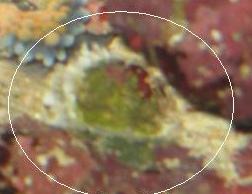 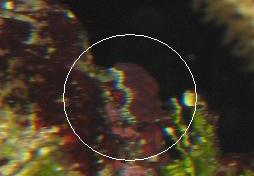 |
|
Hitchhiker bivalve 11/8/08 Hello there! I
hope you're having a great weekend! <Thanks Gareth, yep,
it looks to be a terrific weekend!> For a while now I've
been trying to find an identification for a hitchhiker that
I've had on my live rock since my tank was set up in June
last year. <Neat> I would very much like to get a positive
identification purely because I'm curious to find out more
about it. I've searched here and on the 'net to no avail,
could you please tell me what it is? <I sure wish I could, but
I can't see quite enough detail to narrow it down
sufficiently. Don't get me wrong, you got a great photo,
especially given the fact that these guys never seem to arrange
themselves with our viewing pleasure in mind! What I would need
are at least two good hi-res photos: one taken from directly
above (in order to see the entire shape of the shell and see
where it's hinged) and one from the side (same goes). I'd
also need to know the size and where it hitchhiked in from.
Locale can make all the difference when it comes to ID work. All
is not lost though. I've got a site for you to peruse
that's one of my favorites. It may well enable you to narrow
things down to family or even genus level. Considering the number
of bivalve families and genera out there, that's quite an
accomplishment! At the following site, please see the category
�Bivalves� and select/go
through the various shapes shown. Each shape will take you a page
with photos, and each photo is a link to more photos and
information.
http://shell.kwansei.ac.jp/~shell/pic_book/shape.html - Hope that
helps!> Thanks you very much for your time! Kind regards,
<It was my pleasure, Gareth.> Gareth
<Take care and have a great weekend! -Lynn>
|
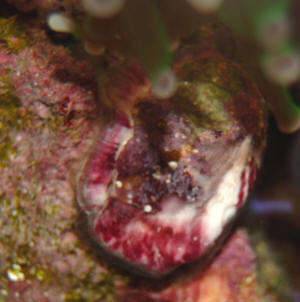 |
|
What is this? A bivalve --
10/10/08 I just had a question about something that has
appeared on my live rock. I noticed a little tiny clam like thing
growing on my live rock I just wasn't exactly sure what it
was. I thought it might be a scallop. If you could identify it
better than I could that would be very helpful. <Is... a
bivalve... akin to that shown here:
http://images.google.com/imgres?imgurl=http://www.timespub.tc/fileadmin/user_upload/featured/Fall%25202004/Shell%252054.jpg&imgrefurl=http://www.timespub.tc/index.php%3Fid%3D41&h=306&w=200&sz=10&hl=en&start=21&um=1&usg=__SU0UmajdRQ8AMYmVpmNXv-ve2uU=&tbnid=dfMqOgjeJlVwQM:&tbnh=117&tbnw=76&prev=/images%3Fq%3Dupright%2Bbivalves%26um%3D1%26hl%3Den%26rls%3Dcom.microsoft:en-us:IE-Address%26rlz%3D1I7PCTA
There are similar species in all tropical to cool water
oceans> Also, I didn't know how big it would get or if it
would be harmful to anything in my tank. <I doubt it will grow
very large in this setting... relies on filter feeding/foods...
and not deleterious> I have a Picasso trigger fish, an algae
blenny, and a flame angelfish. In the picture that I am sending
there are two tunicates the unknown clam like thing is behind the
tunicates. I really appreciate the help. Thanks. <This life is
indicative of good care on your part... as well as initial high
quality of your live rock. I would take care to not change much
of anything in your maintenance, operation routine. Cheers, Bob
Fenner>
|
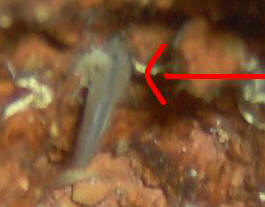 |
|
Liverock Hitchhiker: Bivalve -- 10/8/08 Hey
guys, <Hi there> I love your site and have been reading it
whenever I get the chance. <Super!> When looking through my
live rock for the past month or so, I noticed that when I moved
passed the lower part of my LR, something would move (it would
retract). I have a JBJ NC24 and my parameters are great, but the
nitrates are a little higher than I would like them (20ppm).
<Yep, you definitely want to keep those below 20ppm. For more
information, please see WWM, starting here:
http://www.wetwebmedia.com/nitratesmar.htm > My tank is in the
process of becoming a FOWLR and I have approximately 40 pounds of
LR. I have an attached image of what is in question, I was
originally only able to see the front of it and it looked like a
flower bud; but after turning over the live rock that it is
attached to, I noticed that it resembled an oyster. <It's
definitely a neat little bivalve of some sort. I'm sorry I
can't be more specific, but I'd need to see photos of the
entire shell in order to narrow things down. For more information
regarding bivalves, please see the following link (as well as the
related links at the top of the page):
http://www.wetwebmedia.com/bivalvia.htm > I have an algae
blenny and a snowflake eel in the tank and they both seem to be
doing great =) The blenny in particular gets fatter every day =|
I just wanted to make sure, after finding out what this is, that
it poses no harm to my inhabitants <None whatsoever> and if
it is beneficial; should I consider feeding him anything special?
<You could try one of the foods available for filter-feeding
organisms, (like DT's Phytoplankton) but be careful. Adding
too much (of any food) can lead to problems -- excess nutrients,
nitrates, algae, etc. Please see this link for more information
regarding bivalve feeding:
http://www.wetwebmedia.com/bivfdgfaqs.htm > Thanks for the
help guys, I appreciate it! <You're very welcome! Take
care, -Lynn>
|
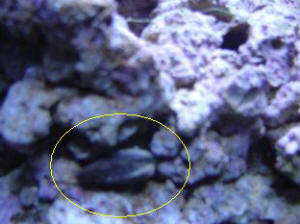 |
strange clam-like object on live rock
-08/05/08 I have a piece of Fiji live rock that has a strange
clam-looking thing attached to the inside of a hole in the rock. It
is usually partially open, but when you slightly bump it with
something it clamps tight against the rock. I have attached four
pictures...3 of it open and 1 of it closed. <Hmm, it's hard
to tell from the photos, but they look like hitch-hiker
oysters/bivalves or possibly tunicates. Please browse the following
links (and their associated ID/FAQs pages):
http://www.wetwebmedia.com/bividfaqs.htm
http://www.wetwebmedia.com/invertidfaqs.htm> I have circled it
with an orange circle. I was curious if you know what it is and if
it is harmful to my other tank inhabitants. <Seems highly
improbable that they're harmful... likely just harmless common
hitchhikers.> I have a Clarkii clownfish and a Sebae anemone in
with it. <Best,
Sara M.> |
|
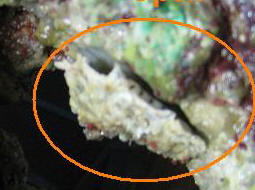 Is a bivalve. RMF Is a bivalve. RMF
|
Live Rock Hitchhikers! 7/18/08 Hello Crew, I am a
somewhat experienced saltwater enthusiast, having about 1 year of
experience with a 55 reef setup. This year was spent with at least 5-10
hours per week spent reading and researching throughout the entire
year.. so it's more than just a 'casual' "hey
let's throw some fish and corals in a tank" kind of
experience... Anyway... I just started a Nano tank, for the
"challenge" of it. After patiently waiting until the water
parameters were stable, I bought myself a nice 3 lb piece of live rock
at the LFS. After a few hours, I was looking at the tank and making
some observations, and I saw a few neat creatures that I had not seen
at the store: a smaller feather duster, some random smaller zoanthid
type polyps (hopefully not aiptasia, but they have a deep body, so
I'm thinking they're not) And I thought that was all really
neat. However, I was looking at the back part of the rock, and it
looked like something large moved! Turns out, I have some sort of clam
that attached to the rock and is covered in beautiful coralline algae
and some macroalgae. All the research I've done about clams has
been the Crocea and Maxima varieties, but this one has the body shape
of a freshwater "eating type" (I hope my descriptions make
sense..) Any ideas on this guy? I have about 3.5 watts per gallon
lighting and the tank is only a 10 gallon, so I'm not sure what
I'll do with this hitch hiker, besides research of course. Thanks
for the much appreciated help and suggestions/insight. Eric <Hello
Eric. Bivalves -- clam, oysters, scallops, and mussels -- are very
diverse, with literally thousands of species known to science. Most are
marine, fairly small, and infaunal, meaning they live in sand, soft
rock or sunken wood. So from your description it is virtually
impossible to put a name to what you have! But you could start here,
and see if anything rings a bell...
http://www.wetwebmedia.com/bivalvia.htm That said, virtually none will
do any harm in an aquarium, so identifying them usually isn't
critical. The main problem with bivalves is that the majority are
filter feeders (a few are micropredators or deposit feeders) so the
bigger species often find it hard going in the largely plankton-free
aquarium environment. If they die from starvation, you have a lump of
rotting protein there messing up your water quality. But small
"hitchhiker" species may well survive, even thrive, without
undue fuss. What you're actually learning about is that marine
invertebrate diversity is an order of magnitude (at least) greater than
freshwater invertebrate diversity. Every piece of living rock will have
representatives of at least half a dozen animal phyla, including ones
you never see in freshwater, such as the Echinodermata and Sipunculida.
So, enjoy your new "pets", go grab a book on marine
invertebrates, and learn about the wonders of marine biology! Cheers,
Neale.>
| What is this on my live rock? 07/07/08 Ok I
was moving around my larger live rock getting ready to move it to
my new 120 reef aquarium and found 7 of these things on the back
part of a rock. It came from a always dark area, and I just wanted
to make sure they are ok, and not bad. I thought it might be some
kind of mollusk, but was told to ask you. Thanks, Clint &
Ashley <Hello Clint & Ashley! Looks like some species of
Spondylus (or "thorny oyster") to me. These are cemented
(i.e., non-motile) scallops. Spondylus have a scallop-like build,
but one valve is cemented to the rock and both valves bear
spoon-like projections that trap algae and sponges and help to
camouflage the animal. Could possibly be Chama spp. though; a
similar organism known as the "jewel box oyster" though
if I recall correctly it is not a member of the oyster/scallop
order Pterioida but some sort of Veneroida. Chama spp. can be
recognised by the very deep valve cemented to the rock with a small
moveable lid-like valve on top (hence "jewel box"). I
remember seeing one of these in a reef tank my father had at home
during the 1980s. Seemed to be very hardy and lasted for years
without any specific care, though I don't offer that as expert
advice on maintenance! Cheers, Neale.> |
|
 Good guess/resp. RMF Good guess/resp. RMF
|
Bivalve Identification... sans pix
04/11/2008 Hello Crew! <<Hello John, Andrew today>> I
apologize in advance for not having a picture to attach (I could not
get one clear enough to make it useful). I am curious if you can help
me with a bivalve ID. I have noticed over the past few months a few
(they appear to be multiplying) of these guys in my tank attached to
the rock work and most recently the tubes of my pipe organ. They have
white shells, similar to an oyster in shape, with what look like
thorny, hard protrusions all around the mantle of the shell. The
interior appears to be white as well. They are all small, being around
a half inch in size. Sorry to be so sparse but I am not sure what other
information might be of assistance. They close quite rapidly when
touched and appear to be fairing well in the tank since I am noticing
more of them. <<I agree, it does sound very much like a Bivalve,
many that it could possibly be from your description. Please read,
peruse of the following webpage, including linked articles and
FAQ's, see if you can spot which you do possess.
http://www.wetwebmedia.com/bivalvia.htm >> Thanks for any
assistance. John <<Sorry to be vague John, however, without a
photo, it makes this too general to answer. Regards. A
Nixon>>
|
Unidentified mollusk 4/7/08 Hi Crew! What a tremendous
resource you guys are - thank you! I would very much appreciate
your help in identifying this creature that I discovered
occupying a nook in a new piece of live rock I acquired. I have a
12 gallon Eclipse system 12 retrofitted with an additional 32
watts (10,000k/460nm) of light. This is a spare tank I had that I
set up in my children's classroom to study invertebrates.
Other occupants in the tank include a percula clown, feather
duster, a couple of emerald crabs, an arrow crab, a couple of
hermit crabs, a peppermint shrimp, yellow polyps, several
Christmas tree worms, a flame scallop, an orange tree sponge, a
red gorgonian and a sand sifting star. At first I thought it was
just one piece of rock lodged into another, then (while staring
like a mental patient at the tank - apparently a common plight
amongst saltwater fish hobbyists) I noticed the rock moving up
and down. A downward shot (photo attached) showed it opening
rather like a bivalve but its positioning makes it hard for me to
understand how it can effectively filter feed. Any help you can
provide would be greatly appreciated. Thanks, Liana <Is an
Arca sp. clam... see the Net, WWM re... Bob Fenner>
Thank you. <Certainly welcome... enjoy! The ongoing
life/health of this bivalve is testimony to your good care.
BobF>
|
|
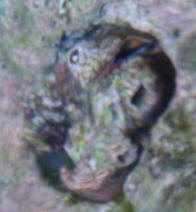
|
|
|

